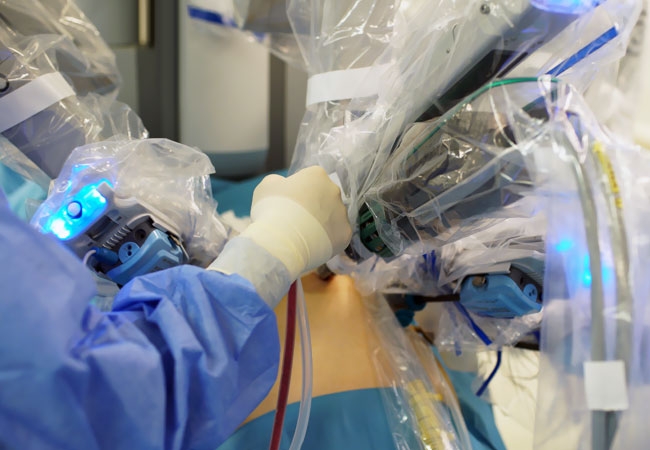Renal (kidney) tumors can be detected at various locations and sizes on the kidney. Important is the early detection of kidney tumors (cancer). Depending on the location and size of the tumor, it may be possible to surgically remove and treat kidney cancer by protecting the kidney while removing the tumor.

Renal tumors can be treated with open surgery with the same level of safety and efficacy as with robotic kidney cancer surgery, which is more comfortable for the patient, carries less risk, and has a shorter recovery period. So, while the tumor is being completely treated, patients can get better and faster healing, more comfort, and better cosmetic results.
Although robotic surgery in urology is most commonly used to treat prostate cancer, it is also used to treat renal tumors in the kidney. Depending on the size and location of the tumor, it is determined whether to perform a total nephrectomy or a partial nephrectomy. Partial nephrectomy therefore refers to the surgical removal of the part of the kidney with the tumor.
If only the part of the kidney that has the tumor needs to be taken out, a robotic system may be needed for a partial nephrectomy. When the whole kidney needs to be taken out, the laparoscopic method is all that is needed. This procedure is known as robot-assisted partial nephrectomy, robotic-assisted partial nephrectomy, or robotic kidney cancer surgery.
In the surgical treatment of kidney cancer, robotic surgery may be preferred. Robotic surgery is the method of choice, particularly for renal partial nephrectomy surgery, in which a part of the kidney is removed
Performing a partial nephrectomy for kidney cancer with a robot protects the kidney's nutrition by causing less damage to the kidney's blood supply during the operation; consequently, it has a protective effect on the kidneys both during and after the procedure. It also magnifies and enlarges the image, allowing for a more controlled and secure removal of the tumor.
Robotic surgery for kidney cancer begins with the laparoscopic technique. In patients undergoing robotic partial nephrectomy of the kidney, beginning the operation with laparoscopic surgery reduces the duration of the procedure and the amount of anesthesia required. Initially, four incisions smaller than one centimeter are made in the patient's abdomen.
Then, through these incisions, special equipments that allow the robot arms to reach the abdomen are inserted. These devices are connected to the robotic system. On this basis, robotic surgery for renal cancer is performed. After surgery, the tumor tissue or other tissues to be removed are placed in a special bag. To remove the tumor, the small incisions made are slightly enlarged to the size of the tumor, and the tumor is extracted from this area.
Robotic kidney surgery for cancer is very different from traditional kidney surgery, which is also called "open kidney surgery". The most obvious benefit is the ability to treat the patient by entering the abdomen through small holes as opposed to making a large incision in the abdomen.
This allows the patient to recover more quickly, have fewer surgical complications, and achieve superior cosmetic results following surgery. In addition to providing a magnified and clearer view for cutting the tumor from the kidney, it enables the controlled and graceful removal of the tumor.
In robotic partial nephrectomy surgery, the robot does not independently perform the procedure. Utilizing the robot, the surgeon in the control unit (console) performs the operation. In addition to the surgeon who controls the robot during the procedure, the robotic surgery nurse and a second surgeon assist the surgeon who uses the robot.
As with any other kind of surgery, a robotic kidney cancer surgery depends on how experienced the surgeon is. The greater the experience of the surgeon performing robotic surgery, the shorter the procedure will be and the fewer complications there will be.
Similar to other surgical procedures, robotic partial nephrectomy of the kidney carries anesthetic risks. An anesthesiologist evaluates each patient before surgery in order to determine and reduce these risks.
In the course of the operation, complications may arise for reasons unrelated to robotic surgery. In kidney partial nephrectomy surgery, which is intended to remove only a part of the kidney and preserve the healthy part of the kidney for various reasons based on the disease and the patient, it may be necessary to remove the entire kidney, i.e., a radical nephrectomy, in certain instances. Additionally, adhesions may necessitate a return to open surgery during the operation. These are extremely uncommon complications.
Especially in surgeries performed by experienced surgeons, these risks are significantly reduced.
The duration of robotic kidney cancer surgery can vary depending on numerous patient-specific factors. The most significant determinants of the duration of an operation are the patient's weight, the size and location of the tumor, and the patient's prior surgical history.
The cost of robotic renal surgery for kidney cancer also depends on factors that are unique to each patient. The anticipated length of the procedure and hospital stay determine the cost of the surgery. Before providing a price to patients, it is necessary to consider additional factors.